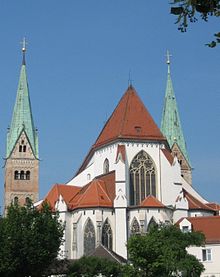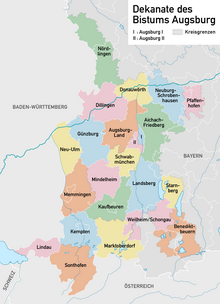
Ulrich of Augsburg, sometimes spelled Uodalric or Odalrici, was Prince-Bishopric of Augsburg in Germany. He was the first saint to be canonized not by a local authority but by the Pope.

The Archbishop of Cologne is an archbishop governing the Archdiocese of Cologne of the Catholic Church in western North Rhine-Westphalia and is also a historical state in the Rhine holding the birthplace of Beethoven and northern Rhineland-Palatinate in Germany and was ex officio one of the Prince-electors of the Holy Roman Empire, the Elector of Cologne, from 1356 to 1801.

The Diocese of Eichstätt is a Latin Church diocese of the Catholic Church in Bavaria. Its seat is Eichstätt, and it is subordinate to the archbishop of Bamberg. The diocese was erected in 745; from the Middle Ages until 1805, it was a state of the Holy Roman Empire. The current bishop of Eichstätt is Dr. Gregor Maria Hanke, OSB; formerly the Abbot of the Benedictine Abbey of Plankstetten, he was named to the See by Pope Benedict XVI on 14 October 2006, and he was consecrated at the Cathedral of Eichstätt on 2 December 2006. The diocese covers an area of 6,025 km², with 48,9% just under half of the population is catholic.
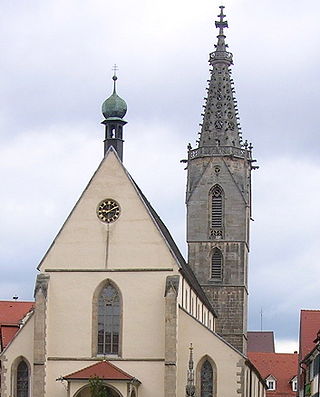
The Diocese of Rottenburg-Stuttgart is a Latin Church ecclesiastical territory or diocese of the Catholic Church in Germany. It is a suffragan in the ecclesiastical province of the metropolitan Archdiocese of Freiburg in Baden-Württemberg, Bundesland. It covers the same territory of the former Kingdom of Wurttemberg.

The Archdiocese of Paderborn is a Latin Church archdiocese of the Catholic Church in Germany; its seat is Paderborn. It was a diocese from its foundation in 799 until 1802, and again from 1821 until 1930. In 1930, it was promoted to an archdiocese. From 1281 until 1802, the Bishopric of Paderborn was also a state of the Holy Roman Empire.
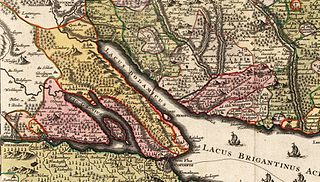
The Prince-Bishopric of Constance, was a small ecclesiastical principality of the Holy Roman Empire from the mid-12th century until its secularisation in 1802–1803. In his dual capacity as prince and as bishop, the prince-bishop also governed the Diocese of Konstanz, which existed from about 585 until its dissolution in 1821, and whose territory extended over an area much larger than the principality. It belonged to the ecclesiastical province of Mainz since 780/782.

St. Ulrich's and St. Afra's Abbey, Augsburg is a former Benedictine abbey dedicated to Saint Ulrich and Saint Afra in the south of the old city in Augsburg, Bavaria.
Dominic Marquard, Prince of Löwenstein-Wertheim-Rochefort was the second Prince of Löwenstein-Wertheim-Rochefort.

The Prince-Bishopric of Bamberg was an ecclesiastical State of the Holy Roman Empire. It goes back to the Roman Catholic Diocese of Bamberg established at the 1007 synod in Frankfurt, at the behest of King Henry II to further expand the spread of Christianity in the Franconian lands. The bishops obtained the status of Imperial immediacy about 1245 and ruled their estates as Prince-bishops until they were subsumed to the Electorate of Bavaria in the course of the German Mediatisation in 1802.

The Roman Catholic Archdiocese of Olomouc is a metropolitan archdiocese of the Latin Church of the Catholic Church in the Czech Republic. It has its seat in Olomouc.

The Prince-Bishopric of Augsburg was one of the prince-bishoprics of the Holy Roman Empire, and belonged to the Swabian Circle. It should not be confused with the larger diocese of Augsburg, over which the prince-bishop exercised only spiritual authority.
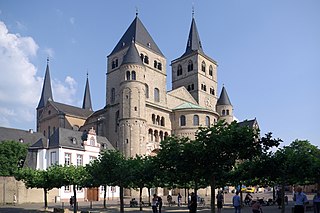
The Diocese of Trier, in English historically also known as Treves from French Trèves, is a Latin Church ecclesiastical territory or diocese of the Catholic church in Germany. When it was the archbishopric and Electorate of Trier, it was one of the most important states of the Holy Roman Empire, both as an ecclesiastical principality and as a diocese of the church. Unlike the other Rhenish dioceses—including Mainz and Cologne–Trier was the former Roman provincial capital of Augusta Treverorum. Given its status, Trier has continuously been an episcopal see since Roman times and is one of the oldest dioceses in all of Germany. The diocese was elevated to an archdiocese in the time of Charlemagne and was the metropolitan for the dioceses of Metz, Toul, and Verdun. After the victory of Napoleon Bonaparte of France, the archdiocese was lowered to a diocese and is now a suffragan in the ecclesiastical province of the Archdiocese of Cologne. The diocesan cathedral is the Cathedral of Saint Peter. The Cathedral Chapter retains the right to elect the bishop, rather than selection by papal appointment.
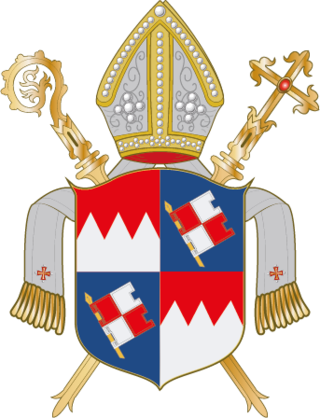
The Diocese of Würzburg is a Latin Church diocese of Catholic Church in Germany. The diocese is located in Lower Franconia, around the city of Würzburg, and the bishop is seated at Würzburg Cathedral. Founded in 741, the diocese lost all temporal power after the Napoleonic wars.
Johann Eglof von Knöringen was Prince-Bishop of Augsburg from 1573 to 1575.
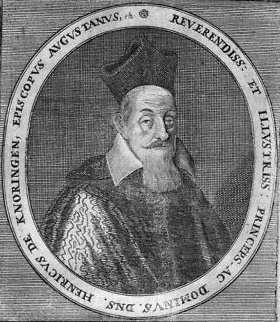
Heinrich von Knöringen was Prince-Bishop of Augsburg from 1599 to 1646.
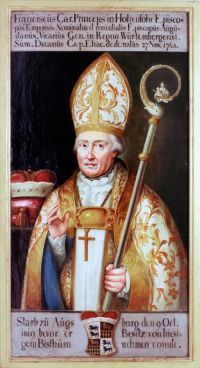
Franz Joseph Xaver Karl Fürst zu Hohenlohe-Waldenburg-Schillingsfürst was a Roman Catholic auxiliary bishop and bishop of Augsburg, as well as vicar general of Neu-Württemberg, later Diocese of Rottenburg.
The Roman Catholic Diocese of Adramyttium was established in the 13th century as a suffragan of Cyzicus, but was later made a suffragan of Ephesus. In 1222, an unnamed bishop was entrusted with a papal assignment.
Jodok Seitz, O. Praem. was a Roman Catholic prelate who served as Auxiliary Bishop of Augsburg (1460–1471).
